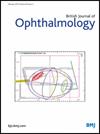青光眼伴视盘出血的眶膜-巩膜界面应力升高
IF 3.5
2区 医学
Q1 OPHTHALMOLOGY
引用次数: 0
摘要
背景/目的基于临床数据,采用患者特异性有限元模型分析视网膜板(LC)-巩膜界面应力,探讨青光眼视盘出血(ODH)发生的生物力学机制。方法回顾性、单中心、模拟为基础的病例对照研究。对个性化视神经头模型在主凝视和10°眼球旋转(内收)两种注视条件下进行有限元模拟。在lc -巩膜界面前后边界处计算von Mises应力。采用方差分析、相关分析和回归分析,评价应激组间差异及其与临床变量的关系。结果共纳入111只眼:原发性开角型青光眼(POAG)合并ODH 44只眼,POAG合并ODH 34只眼,对照33只眼。我们发现POAG合并ODH组与其他组内收前后边界的应力差异有统计学意义(p<0.01)。年龄和轴长与内收时颞lc -巩膜界面应力呈正相关。逻辑回归发现内包诱导的应激与ODH显著相关。多变量分析确定年龄是内收期间压力的最大因素。结论本研究表明,lc -巩膜界面应力的增加可能是青光眼在颞区内收时发生ODH的原因之一。我们还发现,老化和轴向长度变长可能会增加压力,潜在地导致视神经头部小血管的破坏。如有合理要求,可提供资料。已确定的患者数据,包括椎板应力值,可根据合理要求从通讯作者处获得。本文章由计算机程序翻译,如有差异,请以英文原文为准。
Elevated lamina cribrosa-sclera interface stress in glaucomatous eyes with optic disc haemorrhage
Background/aims To investigate the biomechanical mechanisms underlying the occurrence of optic disc haemorrhage (ODH) in glaucoma by analysing the stress at the lamina cribrosa (LC)-sclera interface using patient-specific finite element models based on clinical data. Methods This was a retrospective, single-centre, simulation-based, case-control study. Finite element simulations were conducted on individualised optic nerve head models under two gaze conditions: primary gaze and 10° ocular rotation (adduction). The von Mises stress was calculated at the anterior and posterior boundaries of the LC-sclera interface. Intergroup differences in stress and their association with clinical variables were evaluated using analysis of variance, correlation and regression analyses. Results A total of 111 eyes were included: 44 eyes with primary open-angle glaucoma (POAG) and ODH, 34 eyes with POAG without ODH and 33 control eyes. We found statistically significant differences in stress at both the anterior and posterior boundaries during adduction between the POAG with ODH group and the other groups (p<0.01). Age and axial length were positively associated with stress at the temporal LC-sclera interface during adduction. Logistic regression identified adduction-induced stress as significantly associated with ODH. The multivariate analysis identified age as the strongest contributor to stress during adduction. Conclusion This study demonstrates that increased stress at the LC-sclera interface may contribute to the occurrence of ODH in glaucoma during adduction in the temporal region. We also found that ageing and longer axial lengths may increase stress, potentially leading to the disruption of small vessels at the optic nerve head. Data are available upon reasonable request. Deidentified patient data, including lamina cribrosa stress values, are available from the corresponding author upon reasonable request.
求助全文
通过发布文献求助,成功后即可免费获取论文全文。
去求助
来源期刊
CiteScore
10.30
自引率
2.40%
发文量
213
审稿时长
3-6 weeks
期刊介绍:
The British Journal of Ophthalmology (BJO) is an international peer-reviewed journal for ophthalmologists and visual science specialists. BJO publishes clinical investigations, clinical observations, and clinically relevant laboratory investigations related to ophthalmology. It also provides major reviews and also publishes manuscripts covering regional issues in a global context.

 求助内容:
求助内容: 应助结果提醒方式:
应助结果提醒方式:


